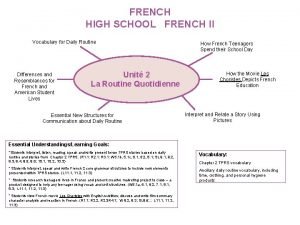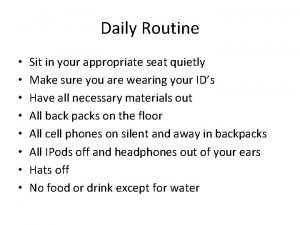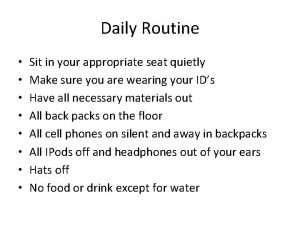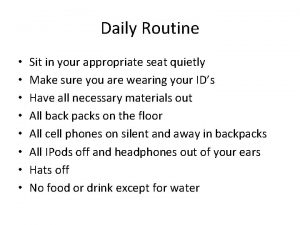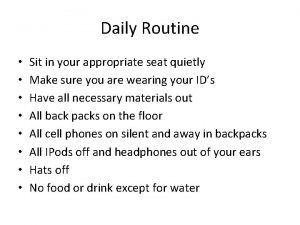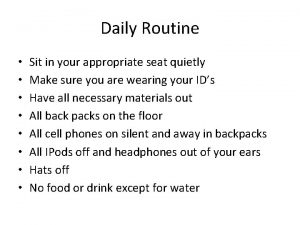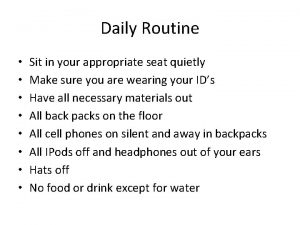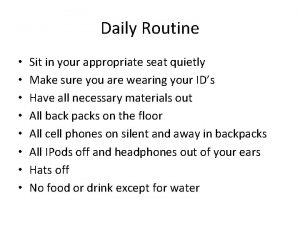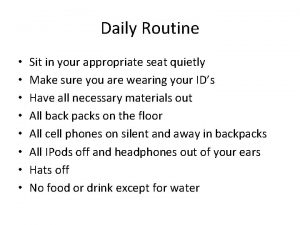Daily Routine Sit in your appropriate seat quietly

































- Slides: 33

Daily Routine • • Sit in your appropriate seat quietly Have all necessary materials out All back packs on the floor All cell phones on silent and away in backpacks • All IPods off and headphones out of your ears • No food or drink except for water • All electronic devices away!!!

Bell Work • Explain how background radiation (gamma waves, microwaves, and radiowaves) help support the Big Bang Theory? • How do galaxies get their classification?

Earth Science Announcements Project Final Draft 11/12/2014 Big Bang and Galaxy Quiz Thursday November 13 th Big Bang, Galaxy, and Stars Test Thursday 20 th

Galaxy Lab • Groups of 4 to 5 at each of the lab stations • Stay with your group, you may not move to other groups • If I notice this, I will choose groups • Complete sections 1 -3, If you finish the first 3 work and complete the final

Stars and their Life Cycle

their short wavelength, X-Rays are even more hazardous to your Gamma Radiation has theby shortest wavelengths of all radiation Violet (UV) radiation from Sun has an even shorter wavelen Radio frared Visible Waves or Light heat are from waves given the have off Sun athe has shorter the an Sun. even wavelength These shorter are wavelength. than long radio waveleng wave why doctor’s put a lead vest over you get for anc Radiation is absorbed by the earth’s ozone layer &radios can cause skin and therefore Just small amounts can be. X-rays fatal. eat waves Light Waves waves and orisradiation create are theform only static type the you sun of get radiation iswhen on what your controls we can see. our andweathe TV’s

Daily Routine • • Sit in your appropriate seat quietly Have all necessary materials out All back packs on the floor All cell phones on silent and away in backpacks • All IPods off and headphones out of your ears • No food or drink except for water • All electronic devices away!!!

Bell Work • Which of the electromagnetic waves are dangerous to us? • Which waves do we use for evidence to help support the Big Bang Theory?

Earth Science Announcements Project Final Draft 11/12/2014 Big Bang and Galaxy Quiz Friday November 14 th Big Bang, Galaxy, and Stars Test Thursday 20 th

Stars and their Life Cycle

Where does light and these waves come from?

The core, where nuclear the Core, fusion. In takes place. Pressures and Temperatures are high enough for Fusion to take place let’s zoom in and what happens H H He. He In the process, energy is released in the form of light &radiation Fusion occurs when 4 hydrogen atoms (light element) combines to form 1 Helium atom (heavier element) Hydrogen, a lighter element is converted into a heavier element, helium

What are star characteristics? Yellow Stars like are Sun are average in brightness & temperature Blue Stars are large hot and bright Red Stars are small cool and dim

How do we use the H-R Diagram? • In the early 1900’s, Ejnar Hertzsprung and Henry Russell found a way to classify stars • They classified stars by their temperature and brightness http: //www. youtube. com/watch? v =HEheh 1 BH 34 Q&feature=fvw Blue Massive Stars Supergiants Giants Sun Hot White Dwarfs Red Dwarfs Hot Bright Blue Stars Yellow Orange Average Stars Cool Red Dim Stars

• How do we use the H-R Diagram? Hertzsprung and Russell came up with a graph that shows the relationship between temperature and brightness • Notice where the cool small red dwarfs stars are located • Notice where the massive hot blue dwarfs stars are located Blue Massive Stars Supergiants Giants Sun Hot White Dwarfs Red Dwarfs Hot Bright Blue Stars Yellow Orange Average Stars Cool Red Dim Stars

What are Main Sequence Stars? • Our sun is a yellow Main Sequence Star • Main Sequence Stars that fit into a diagonal band that run from the upper left to the lower right corner • Main Sequence Stars contain large, hot blue stars, as well as small cool red stars • 90 % of all stars are Main Sequence Blue Massive Stars Sun Red Dwarfs Hot Bright Blue Stars Yellow Orange Average Stars Cool Red Dim Stars

What determines Star Size? A star will begin it’s main sequence when hydrogen fusion begins Gravity wants to crush the star So why doesn’t it? Because the outward pressure Or force of energy from Fusion balances out the inward force of gravity This keeps the star in a state of balance or equilibrium!

Daily Routine • • Sit in your appropriate seat quietly Have all necessary materials out All back packs on the floor All cell phones on silent and away in backpacks All IPods off and headphones out of your ears Hats off No food or drink except for water All electronic devices away!!!

Bell Work • How does a star maintain its shape? • Describe how fusion works.

Earth Science Announcements Project Final Draft 11/12/2014 Big Bang and Galaxy Quiz Thursday November 13 th Big Bang, Galaxy, and Stars Test Thursday 20 th

Stars and their Life Cycle

Temperature & Pressure Affect Star Life Full Hydrogen Empty Large massive blue stars have Short lives Because they have higher pressures & temperatures in the Core, therefore they run through their Hydrogen fuel source faster Hydrogen Empty Full Hydrogen Empty Star like our sun have average lives Full Small Red dwarf stars have long live because of cooler temperatures in the core

Massive Blue Star Lifecycle In a massive blue stars core, hydrogen fuses together to form Helium for most of its short Main sequence life Eventually hydrogen starts to run out and helium starts to accumulate Helium Carbon Helium As a result gravity wants to crush the star, pressures & temperatures increase, & the star begins fusing helium into carbon Over time the outward pressure or force of energy from fusion becomes stronger than the inward force of gravity & the star begins to swell & cool changing its color in the process

Massive Blue Star Lifecycle Temperatures continue to increase in the core, & the star begins fusing Carbon into Oxygen Carbon Oxygen At this point the star is now a supergiant Helium Carbon Helium Hydrogen But fusion doesn’t stop Just yet!!!!!

Massive Blue Star Lifecycle Finally, as temperatures continue to increase the star will begin fusing oxygen into Iron Carbon Oxygen Helium Carbon Helium Hydrogen Near the end of it’s life The blue massive star resembles an onion with layers of different elements This process is called Nucleosynthesis—Where Lighter elements are created into heavier elements through Fusion in a star

Massive Blue Star Lifecycle In massive blue stars Elements up to the size of Iron-element 26 are created Through fusion Iron Carbon Oxygen Helium Carbon Helium Hydrogen

Massive Blue Star Lifecycle At a certain temperature, Fusion can no longer occur and the outward energy stops, at this point gravity takes Black Hole Neutron Star Over and crushes the star Iron Carbon Oxygen The star explodes into a super nova!!! Helium Carbon Depending upon the stars initial mass or size, It will end up Hydrogen as either a neutron star or Black hole Helium

Massive Blue Star Lifecycle When the star explodes, it blasts all The elements into space, seeding the universe with Elements to make new stars, planets, people and buildings Supernovas are so hot & bright, They produc all other elements heavier than iron Iron Carbon Oxygen Helium Carbon Helium Hydrogen

Yellow Star (Sun) Star Lifecycle Our sun’s core will fuse hydrogen into Helium for most of its 10 billion year old Main sequence life Carbon Helium Throughout this time Helium Will accumulate in its core As a result of gravity crushing the star, pressures & temperatures increase & the star begins fusing helium into carbon Over time the outward pressure or force of energy from fusion becomes stronger than the inward force of gravity & the star begins to swell & cool changing its color in the process

Yellow Star (Sun) Star Lifecycle Temperatures continue to increase in the core, & the star begins fusing Carbon into Oxygen Carbon Helium Oxygen Helium Carbon Helium Hydrogen At this point the star is now a Red Giant Unlike a blue star, temperatures and pressure are not high enough To produce Iron through fusion Fusion stops at OXYGEN

Yellow Star (Sun) Star Lifecycle Carbon Helium Oxygen Helium Carbon Helium Hydrogen Instabilities in the balance Between Gravity & outward force or Pressure of fusion result in abrupt explosions that blow away the outer layers of the star The result is a planetary nebula with a hot white dwarf star in the middle

Yellow Star (Sun) Star Lifecycle Eventually the Gases are expelled Leaving behind A white dwarf star is what remains of an average star like our sun after Running out of fuel It’s about the size of earth

Summarize: ? ? ? ? Answer Bank White dwarf Black hole red giant Supernova 10 ? ? ? ? • Our sun has ______ billion year life span
 Please sit down and your seat belts
Please sit down and your seat belts Hey hey people
Hey hey people Sit in your assigned seat
Sit in your assigned seat Sit in your assigned seat
Sit in your assigned seat Sit in your assigned seat
Sit in your assigned seat Seat and sit
Seat and sit Sit in your assigned seat
Sit in your assigned seat He took his seat quietly
He took his seat quietly Awubis
Awubis He took his seat quietly
He took his seat quietly When everybody wears a uniform the rebel
When everybody wears a uniform the rebel Sit down quietly
Sit down quietly Sit down quietly
Sit down quietly Greensboro sit in significance
Greensboro sit in significance Daily routine paragraph in spanish
Daily routine paragraph in spanish Write an essay about daily routine
Write an essay about daily routine Daily routine in arabic
Daily routine in arabic Pseudocode for daily routine
Pseudocode for daily routine Me and my daily activities
Me and my daily activities Ma routine quotidienne essay
Ma routine quotidienne essay Daily routine french vocabulary
Daily routine french vocabulary Daily routine essay in chinese
Daily routine essay in chinese Reading daily routine
Reading daily routine Ma routine de la journée
Ma routine de la journée My daily routine in present continuous tense
My daily routine in present continuous tense Get it up 4
Get it up 4 Describe your morning routine
Describe your morning routine Quietly happy meaning
Quietly happy meaning Adverbs modifying other adverbs
Adverbs modifying other adverbs Types of speakers in a poem
Types of speakers in a poem Jabari is thinking of three numbers
Jabari is thinking of three numbers If they have time in the weekend they will come to see us
If they have time in the weekend they will come to see us Richard cory figurative language
Richard cory figurative language Enter quietly
Enter quietly




















